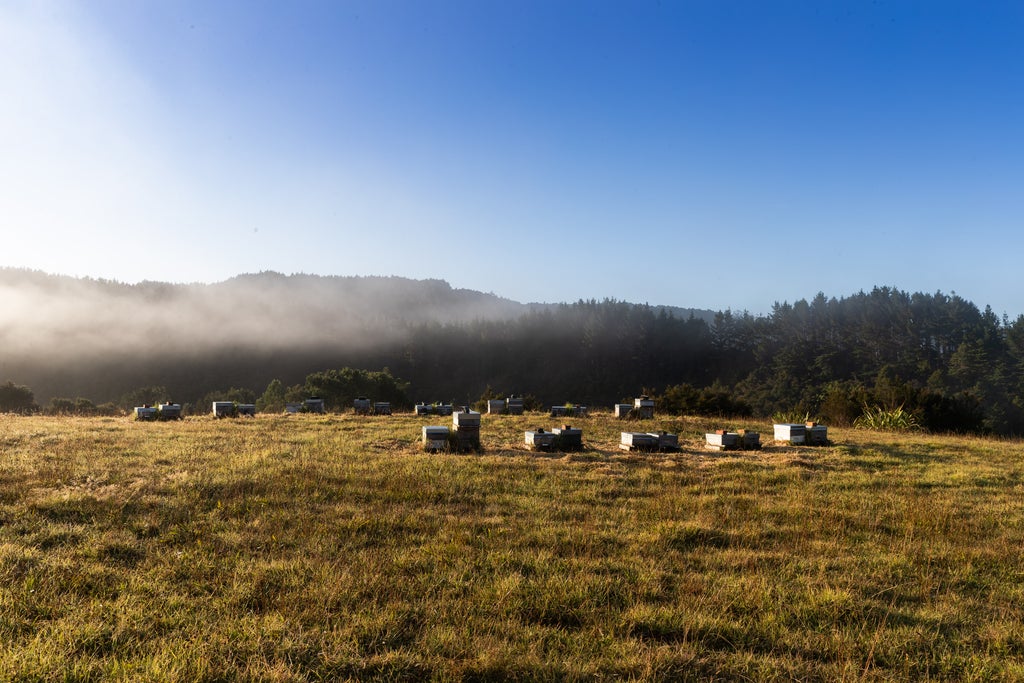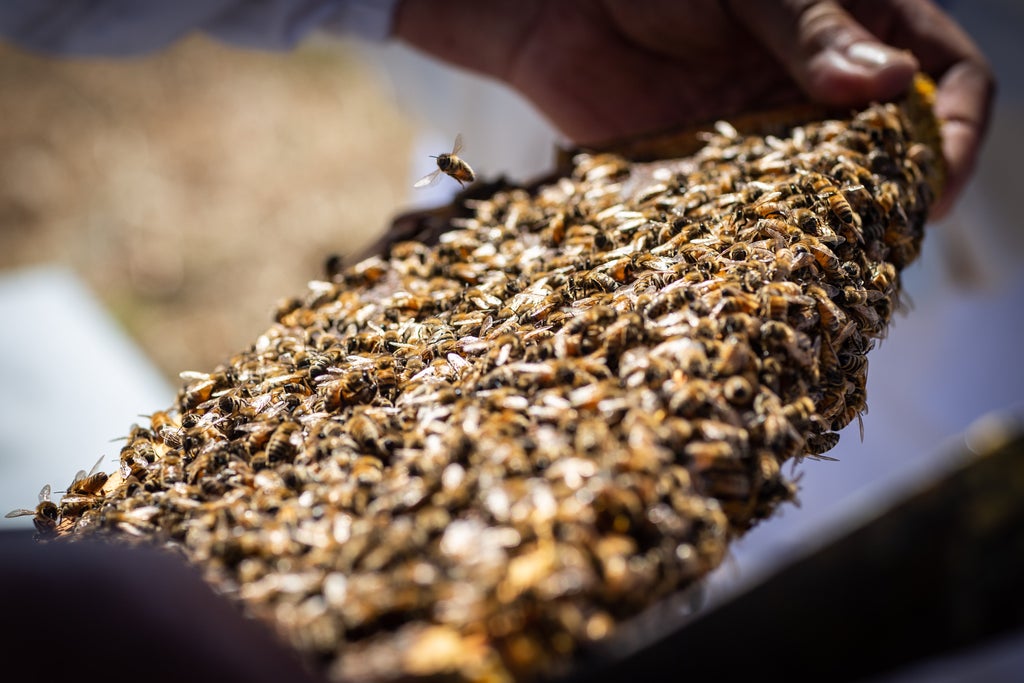At some point in my adult life I developed a not-insignificant fear of bees. There was no traumatic incident to sabotage my relationship with God’s finest flying insects, just an accelerated heart rate whenever one gets too close and the occasional nightmare about having them caught in my hair. And yet, standing before 40 beehives at the Snowberry Gardens just north of Matakana, New Zealand, about an hour-and-a-half drive from Auckland, I feel strangely at peace. Maybe it’s my head-to-toe protective covering, or the steady drone of hundreds of thousands of bees acting as a kind of mind-numbing white noise — or the fact that I am, for the first time, witnessing them doing their jobs, and it’s pretty incredible.
These particular worker bees are in the business of making honey from the four surrounding acres of Kunzea ericoides, or Kanuka trees. Rarer than its close (and much better-known) relative manuka, kanuka honey is unique to New Zealand — but its appeal as a skin-care ingredient goes well beyond its scarcity.
For centuries, honey has been used in both folk remedy and modern medicinal contexts to treat wounds and skin irritations; its efficacy as an antibacterial and anti-inflammatory ingredient is well-documented. But not all honeys are made alike, and where manuka honey from New Zealand was once considered the gold standard in healing honeys, recent research shows kanuka outdoing it. When tested against manuka, a kanuka/manuka blend, and clover honey in a 2014 study, kanuka exerted the most powerful anti-inflammatory effect and stimulated the most significant immune response. (Clover honey, the kind you might get out of a bear-shaped squeeze bottle, had none at all.)

Indeed, a 2011 article published in Immunopharmacology and Immunotoxicology found that kanuka honey’s high concentration of arabinogalactan proteins (AGPs), which are known immunostimulators, contribute to its wound-healing, skin-strengthening properties. “A strong immune response is essential for soothing and repairing damaged or inflamed skin conditions such as acne, redness, eczema, and rosacea, all concerns that are detrimental to radiant skin,” explains Dr. Travis Badenhorst, president of the New Zealand Cosmetics Society and chief scientist at Snowberry.
The nature-forward, New Zealand-based skin-care brand was founded 13 years ago by cosmetician Soraya Hendesi — born of necessity, she says, when she felt she “couldn’t trust” existing products on the market. In 2018, Snowberry was purchased by personal-care behemoth Procter & Gamble Co., which has committed to putting its resources behind the brand’s international growth and marketing without changing its current processes. Hendesi and her husband, Mark Henderson, still run the show, and Dr. Badenhorst lives on the grounds at Snowberry Gardens. He maintains his own lab within walking distance of the hives, amid rolling green hills and Harakeke (also known as New Zealand flax, another star player in Snowberry’s product lineup) bushes that can grow 10 feet high.
There, Dr. Badenhorst developed a proprietary extraction method that eliminates the stickiness of kanuka honey without compromising its potency, which means products like Snowberry’s New Radiance Face Serum and Rejuvenating Night Cream get all the soothing, nourishing power of kanuka without the undesirable feel. Pure, raw kanuka can be purchased online to be slathered on as a DIY face mask or spot treatment, but few brands have managed to harness its benefits without the stick. One other company, HoneyLab, did it by combining 90% pharmaceutical-grade kanuka with 10% glycerin for spreadability. In a randomized controlled trial testing that product for the treatment of rosacea, the combination was found to be effective when compared with Cetomacrogol, an emollient cream often used as a base for topical medications like hydrocortisone.

So why isn’t kanuka honey in everything, poised to take hold as the bee product du jour, when Theodore Rosen, MD, professor of dermatology at Baylor College of Medicine, pronounced it the “new manuka” at a Global Academy for Medical Education conference last year? In addition to the fact that kanuka trees are endemic to New Zealand, whereas manuka trees also grow in Australia (and can even survive in certain areas of the U.S.), the ingredient’s usage raises real concerns of sustainability. Honey is a natural resource, produced in finite amounts; the honeybee population is rapidly dwindling worldwide — by nearly 40% in the U.S. between October 1, 2018, and April 1, 2019, alone. Sticking kanuka honey in products to improve our skin without considering where it comes from is a symptom of greed.
By having their own hives on the grounds, the Snowberry team is able to do more than produce their own honey without disturbing the fragile ecosystem: Their bees give back by pollinating plants in the surrounding areas. Then, once a year, around February or March, the kanuka trees on the Snowberry property begin to bloom into soft, downy pale pink and white flowers. This is when the brand’s in-house beekeepers choose the strongest hives from which to carefully remove the bees and extract honey from the combs. Each hive produces anywhere from 30 to 50 kilograms of kanuka honey per season; only a small portion of that is needed each year to create the actives that go into Snowberry skin care.
It all sounds great on paper: a sustainable skin-care brand with a carbon-neutral certification on a mission to “leave the planet better than they found it.” Snowberry’s product range prioritizes efficacy and safe, natural ingredients in equal measure. But when are we ever lucky enough to see that kind of dedication in action, with our own eyes? There I was, a beauty editor sweating in an ill-fitting bee suit, humbled by my privilege and by the surly older Frenchman whose life’s work is to keep the bees buzzing, to keep track of the queen of each hive, to handle each bee with such great care — his weathered hands free of gloves, his ankles exposed, unafraid of being stung.
There are too many things we take for granted: bees, the ability to travel, the ability to go outside. Not three weeks after I left lush, sun-soaked New Zealand to return to cold, gray New York — the city I was born in, the one I’ll probably never leave — the mayor announced a citywide shelter-in-place order as a result of the pandemic.
New Zealand, helmed by the brilliant Prime Minister Jacinda Ardern — young, female, progressive — has virtually eliminated the virus. Companies like Snowberry have been able to manufacture and ship products while practicing safe social distancing throughout the process. In New York, it feels like nothing will ever be the same. I long not only for drinks with friends and days in the park but for tiny nuisances, the things I would, on an average day, swat away from my head like a bee getting a little too close. I long to hear life in my ear, to whip around and watch it take flight. Bzzzzzt.
We’re here to help you navigate this overwhelming world of stuff. All of our market picks are independently selected and curated by the editorial team.
from refinery29
The Rare, Skin-Healing “Super Honey” You’ve Never Heard Of
![The Rare, Skin-Healing “Super Honey” You’ve Never Heard Of]() Reviewed by streakoggi
on
May 07, 2020
Rating:
Reviewed by streakoggi
on
May 07, 2020
Rating:




